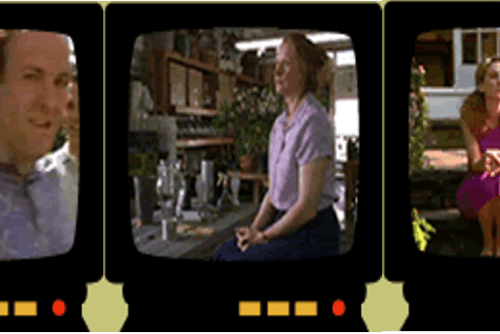Sex and the City‘s unapologetic taxonomy of sex about town, full of style and humor, frequently served as a vehicle for the reconsolidation of heterosexual norms. Samantha in season 1 offers something close to a Naomi Wolf–type critique of the beauty industry when she states that we reside in a culture that promotes its impossible standards, yet season 5 reveals her as no stranger to Botox and depicts her chemical peel’s scorched aftereffect. Carrie appraises her two-minute foray into bisexuality as a “game” that she “was too old to play,” presenting this sexual orientation as not quite adult, after Samantha, calling it a “layover on the way to gaytown,” thus dismisses it as a geographically undesirable dead-end (“Boy, Girl, Boy, Girl,” episode 34).
To return once again to the pilot episode, when Carrie’s voice-over welcomes us to the “age of un-innocence” she attempts to prepare the viewer for its nudity and adult content, as well as the series’ revisiting of Edith Wharton’s preoccupation with women on the market. Yet, the legacy of Sex and the City has taught us that more sexual positions do not always make for better sex or sustained audience engagement. Its humor and effervescence ironically leave the feminist critic face-to-face with a more serious methodological issue. Is the “Is this all feeling” the feminist media critic may feel toward the series itself symptomatic of a moment within her discipline? To what extent is this “age of un-innocence” also a methodological one? Watching the show and reading existing commentary on it may indeed leave the feminist scholar with a vague morning-after effect. The luxe surfaces, like a dexterous conference paper, produce pleasure in the audience but don’t really shake things up in any substantial way. This pleasure in the stylishness of sexual representation in feminist media studies can seem transient. Indeed, feminist theory risks running too close to the fashion pages of the average women’s magazine, offering a knowing self-reflexivity along with the latest styles to bolster its glossy surfaces, but lacking sufficient critique.
Maybe the real un-innocence is that such critique has come to feel too strident and unplayful. Late heterosexuality’s emphasis on style dovetails with postfeminism’s move away from the more polemical, humorless aspects of the second wave. Just as Charlotte’s 1950s image of marriage and home is out of date, so too is the dismantling hierarchies trend, but unlike the former this is not necessarily something to celebrate.
Works Cited
Akass, Kim and Janet McCabe. Introduction. Reading Sex and the City: Critical Approaches. By Akass and McCabe, 1–14. London: I. B. Tauris, 2004.
Blau, Peter M. Exchange and Power in Social Life. New York: John Wiley and Sons, 1964.
Cameron, Samuel and Alan Collins. Playing the Love Market: Dating, Romance, and the Real World. London: Free Association, 2000.
Egan, Jennifer. “Love in the Time of No Time.” New York Times Magazine, November 23, 2003, 66–71, 124.
Greenwald, Rachel. Find a Husband After 35 Using What I Learned at Harvard Business School. New York: Ballantine, 2003.
Hochschild, Arlie Russell. The Commercialization of Intimate Life: Notes from Home and Work. Berkeley: University of California Press, 2003.
Homans, George Caspar. Social Behavior: Its Elementary Forms. New York: Harcourt Brace, 1961.
Illouz, Eva. Consuming the Romantic Utopia: Love and the Cultural Contradictions of Capitalism. Berkeley: University of California Press, 1997.
Kipnis, Laura. Against Love: A Polemic. New York: Pantheon, 2003.
Lee, John Alan. “Ideologies of Lovestyle and Sexstyle.” In Romantic Love and Sexual Behavior: Perspectives from the Social Sciences, edited by Victor C. de Munck, 33–76. Westport, CT: Praeger, 1998.
Mead, Rebecca. “Love for Sale.” Review of Find a Husband After 35 Using What I Learned at Harvard Business School, by Rachel Greenwald. New Yorker, November 24, 2003, 104–7.
Melamed, Samantha. “A Decent Proposal.” Bucks, May/June 2004, 116.
Molloy, John. Why Men Marry Some Women and Not Others: The Fascinating Research That Can Land You the Man of Your Dreams. New York: Warner Books, 2003.
Moore, Myreah and Jodie Gould. Date Like a Man to Get the Man You Want. New York: HarperCollins, 2000.
Murstein, Bernard I. Who Will Marry Whom?: Theories and Research in Marital Choice. New York: Springer, 1976.
Parker, Sarah Jessica and Oprah Winfrey. “Oprah Talks to Sarah Jessica Parker.” O, The Oprah Magazine, March 2004, 186–89, 240.
Parsons, Deborah. L. Streetwalking the Metropolis: Women, the City, and Modernity. Oxford, UK: Oxford University Press, 2000.
Rich, Adrienne. “Compulsory Heterosexuality and Lesbian Existence.” In Adrienne Rich’s Poetry and Prose: Poems, Prose, Reviews, and Criticism, edited by Barbara Charlesworth Gelpi and Albert Gelpi, 203–24. Rev. ed. New York: Norton, 1993. Originally published in Signs 5.4 (Summer 1980): 631–60.
Sex and the City. Created by Darren Star. HBO. 1998–2004.
Straker, Wendy. Sexy Jobs in the City: How to Find Your Dream Job Using the Rules of Dating. New York: Hangover Productions, 2003.
Thibaut, John W. and Harold H. Kelly. The Social Psychology of Groups. New York: John Wiley and Sons, 1959.
Zieger, Susan. “Sex and the Citizen in Sex and the City‘s New York.” In Akass and McCabe, Reading Sex and the City, 96–111.
Zernike, Kate. “Just Saying No to the Dating Industry.” New York Times, November 30, 2003, Fashion and Style sec. http://www.nytimes.com.




